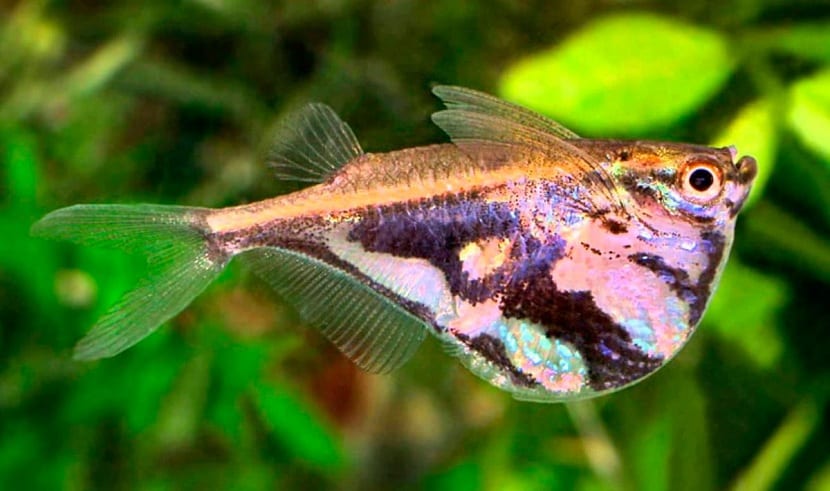
There are some fish that resemble other animals such as the crocodile fish or Roosterfish, but there are also other fish that resemble certain objects such as the sawfish and the protagonist of this article: the ax fish. It has an enlarged belly in such a way that it creates an ax. There are many people who have acquired it for their aquariums and it is becoming fashionable.
In this article we will teach you everything about the ax fish.
Key features
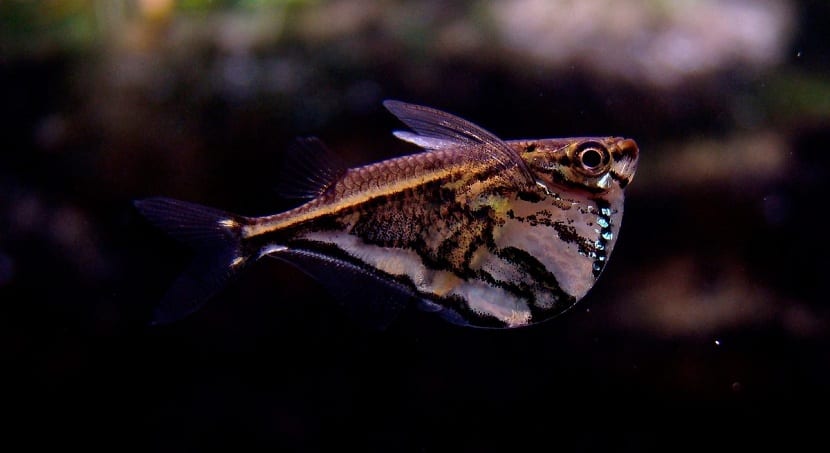
Freshwater axfish belong to the Gasteropelecidae family. It is about de peces from South and Central America. For people who are fond of fish, this species is perfect. It has a deep body that is shaped like an ax. It is usually a small fish that will have a length of about 6,5 cm maximum and usually lives between 2 and 5 years of age.
They are quite active fish if they are in a school of at least 8 or more fish. It is a very curious and active species, which is why it is gaining fame among keepers. de peces. They are white with a silver appearance. They have a black horizontal line that runs through the entire body. Their mouth is located on the top of their head, so they have the ability to feed on the surface.
It is a species that is often confused with other ax fish of other varieties. The common ax fish is a difficult thing to care for, but it becomes a challenge for the more experienced.
Its natural habitat is in South America in Brazil and in the areas where the southernmost tributaries of the Amazon are found. They are usually inhabited by areas with smaller streams but with a high density of vegetation.
The abundant vegetation is his favorite since he can hide among it and feel protected. You usually spend most of your time on it. They will only leave the most abundant area when they feel threatened or to feed. They can sometimes be seen coming out of the water to hunt flying insects.
Food
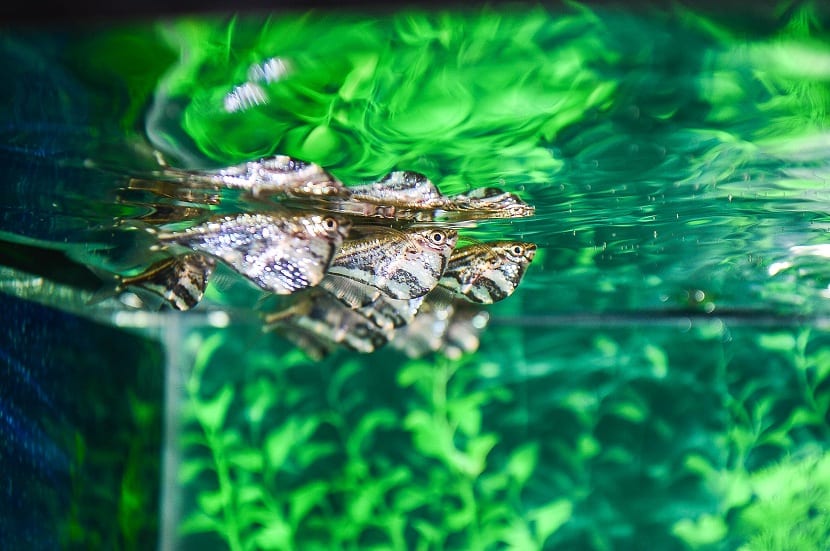
They are carnivorous animals. Its mouth is located on the upper part of its body and serves to feed on the surface. They do not usually eat a food that has already fallen to the bottom of the stream, since they consider it to be in poor condition. They usually feed on those fed that fall on the surface or on other species de peces that swims on or near the surface.
The food that he pursues is the one that is above them, he never lowers the level to capture any prey. When found in the wild, it can catch some vinegar flies, mosquito larvae, and just about any food that's on the surface of the water.
If we want to have it in the aquarium, we must bear in mind that it will only eat the food that is superior to it and that it will not survive only with flake food.
You must provide a balanced diet based on all kinds of foods. For example, mosquito larvae and fruit flies, as well as some live bloodworms or brine shrimp can serve as good sources of healthy protein. Of course, it is not necessary to feed it with it daily.
The diet must be varied not only in nutrients, but also in live and dead food. Don't just make the mistake of giving it scales.
Behavior of the ax fish
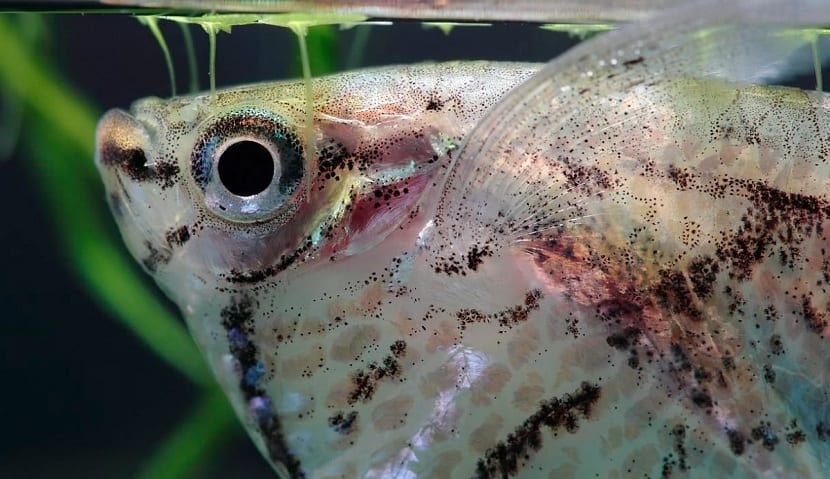
If we are going to have it in community aquariums with other species de pecesIt must be taken into account that it will be a relatively shy and nervous fish. This is the reason why they have to be placed with other passive fish like them. Some variety of fish that is more aggressive is not recommended. In the extreme case of having to make them live together, We must put a school of at least 8 or more ax fish.
If we put it in a school they will adapt more quickly to life in captivity. Also, as we have mentioned before, they will become more active fish, having a longer life accordingly. The best fish to accompany them are tetras, corydoras and loricars.
It is a nocturnal fish that likes to jump out of the water. There are times when it can be seen motionless under the surface of the aquarium water. This is an adaptation that comes from its natural habitat where it is placed there to be able to jump and "fly" through the air to be able to hunt some flying insects.
Necessary care
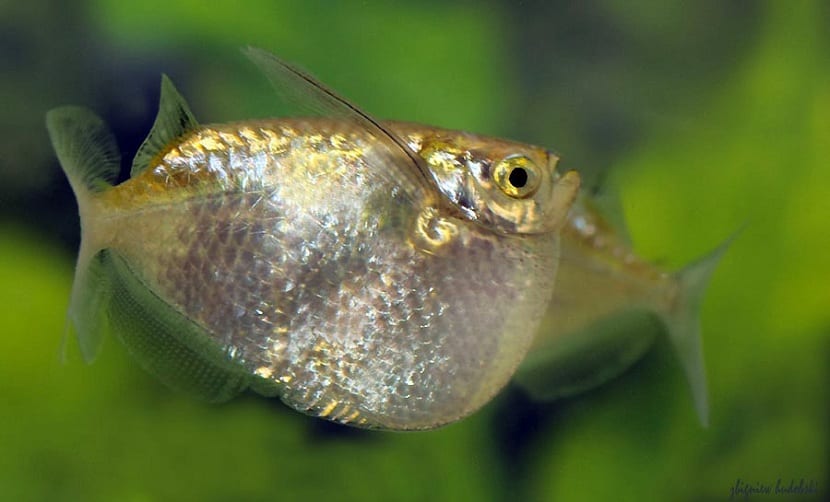
They are becoming a really famous species in the aquarium world since their care is relatively easy. They are animals that, once acclimatized, will always remain healthy. The water must be kept clean and the aquarium system must be closed. Regardless of the size of the aquarium, it must be maintained and cleaned often. The most normal thing is that the organic matter present in the aquarium decomposes and begins to contaminate the environment.
It is somewhat more sensitive to this type of situation. You also have to take into account the hardness of the water. The water must be changed regularly to maintain good conditions. At least 25-50% of the aquarium water should be replaced every two weeks. Thus, the acclimatization process is more positive.
They are fairly disease resistant fish as long as the tank is between 15 and 20 gallons in size. If you decorate the aquarium with floating plants and numerous aquarium plants they will be grateful. This is because in their natural habitat they have these conditions and they just need to recreate them.
It is recommended that the tank is hermetically closed so that the fish does not fall out if it jumps on instinct. Water conditions must be mild and acidic for them to thrive. A peat filtration is advised. Regarding the substrate and the lighting, it can be normal to moderate. The temperature should be between 22 and 27 degrees with a pH between 6 or 7,5.
I hope these tips help you enjoy ax fish.